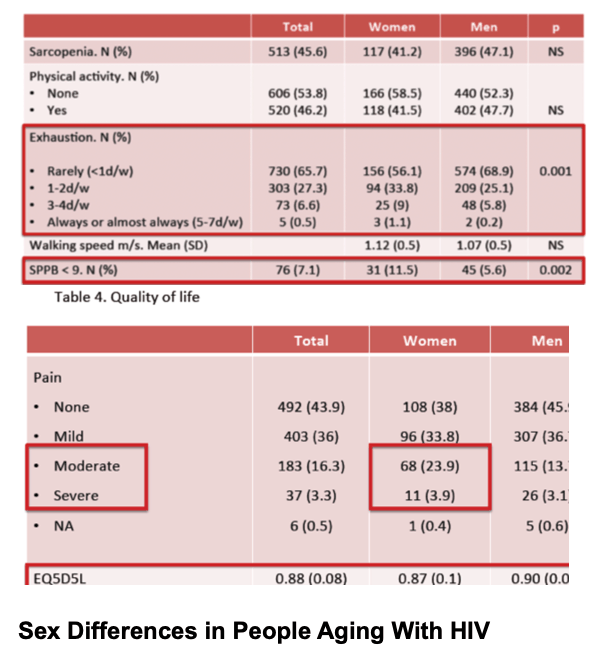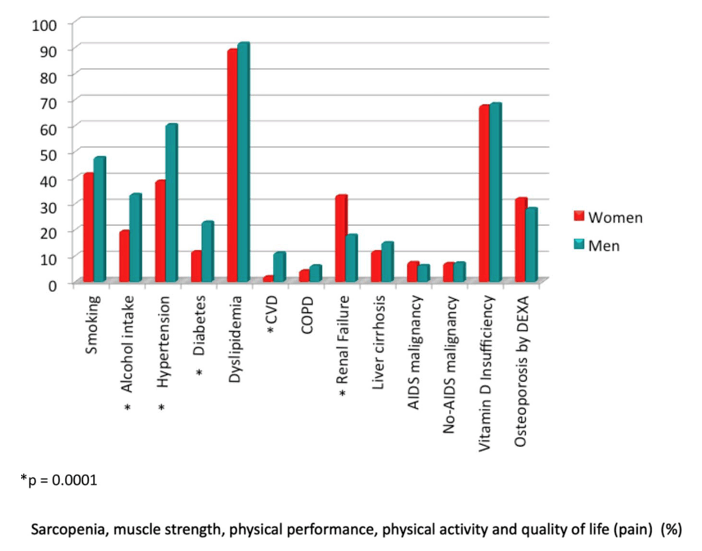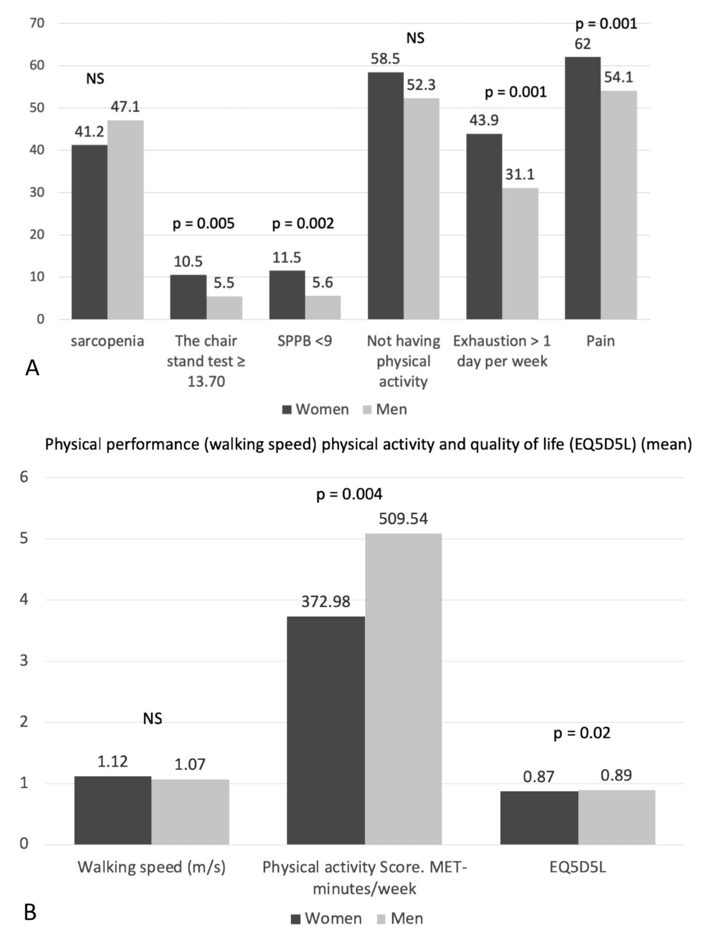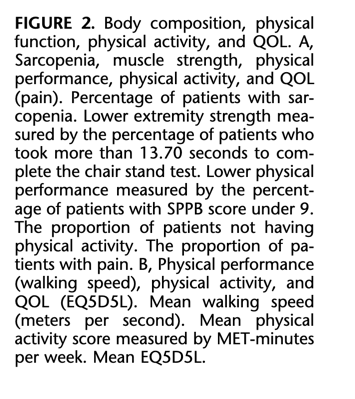| |
Sex Differences in People Aging With HIV - women have worse
quality of life & physical function & suffer more exhaustion
|
| |
| |
Download the PDF here
PWH are considered older adults when in their 50s due to their accentuated aging and an early immunosenescence clinically noticeable by their premature presence of comorbidity, geriatric syndromes, and frailty.18 The population of our study can be considered “the youngest of the older adults” since most of them were in their 50s and just around 10% were 65 years or older. They were quite a fit population as well, according to the FI, which was below 0.2 in both women and men. These facts make the results particularly interesting. They highlight that there are already differences between women and men in their paths of aging in the early aging stage, despite their apparent good health conditions.
In our cohort of HIV adults aged 50 years old or above, women represented one in 4 of the total patients. Despite the fact that women have better immunological recovery measured by CD4 T-cell count and CD4/CD8 ratio, and fewer CVD and cardiovascular (CV) risk factors than men, their physical function and their QOL are worse.
Despite the fact that 20%-30% of the PWH in developed countries are women and one in 3 of new adult HIV infections occur in women, few studies are centered on this specific group.
The main objective of our study was to evaluate differences between women and men with HIV aged 50 years plus, in HIV variables, comorbidity, physical function, and quality of life (QOL).
Sarcopenia and slower gait speed were found more prevalent among men, but without significant differences. Significant differences were found regarding lower extremity strength measured by the chair stand test and in the short physical performance battery score. Short physical performance battery <9 was detected for 11.1% women vs. 5.6% men (P = 0.002). EQ5D5L (quality of life) score was 0.87 in women vs. 0.89 in men (P = 0.002).
In our cohort, older women represented one in 4 of the total patients. Despite the fact that women have better immunological recovery measured by CD4 T-cell count and CD4/CD8 ratio, and fewer CV disease and CV risk factors than men, their physical function and their QOL are worse. Therefore, older HIV-infected women have special characteristics, and the assessment of physical function in this group seems to be crucial.
The other most relevant result of our study is that the QOL of women was worse than that of men.
According to our results, despite the fact that our population was aging quite well, physical function needs to be routinely tested to detect those at risk of functional decline, which will allow health care providers to establish preventive actions and early interventions. Such testing is especially necessary among women with HIV in their 50s. In our study, the intensity of physical activity was shown as a likely key factor affecting the physical performance of older women with HIV. Therefore, physical activity must first be incorporated into the routine clinical records of older adults (those in their 50s and older) with HIV, especially for women. Its intensity has to be measured to design a personalized exercise regimen.
Exercise training preserves strength and muscle mass in PWH under HAART,51 and both moderate-intensity and high-intensity exercise have demonstrated significant improvements in physical function in PWH.52
One of the most relevant results of our study was that physical function was worse in women. This can be considered normally expected as in the general population men perform better than women across all ages;35 however, this loss of physical function in women with HIV occurs at a younger age. We also found interesting differences related to which has been described for general population. In the older HIV-negative population, 15 years older than our study's population, women perform worse on the SPPB, gait speed, and the chair stand test36 and sarcopenia has been demonstrated to be more common in older women than in older men37 In our study, the percentage of women with an SPPB score lower than 9, which means functional impairment, was double that in men, despite the fact that walking speed tended to be faster in women and sarcopenia tended to be more prevalent among men. However, women needed significantly more time (in seconds) to complete the chair stand test. This highlights the idea that low muscle strength overtakes the role of low muscle mass as a principal determinant of physical performance.38 It has been demonstrated in the general population that strength is better than mass in predicting adverse outcomes.39,40 Because of this, the definition of sarcopenia has recently changed to include this concept, and in the revised guidelines,38 muscle strength comes to the forefront. In our study, sarcopenia was defined in quantity of the muscle mass (ASBMI score), and the quality of the muscle was measured separately by the muscle strength and the physical performance. Despite the lack of evidence for loss in skeletal muscle mass, fatigue and some deficits in physical function have been demonstrated among asymptomatic older HIV-infected people.41 Sarcopenia in PWH is age-related and HIV-related due to the elevated inflammation and immune activation.41 We found higher quantity of muscle mass in women than in men, but worse quality of muscle in physical performance. Reduced physical performance has independent effects on mortality among PWH.42 An independent association between HIV infection and reduced physical performance has been demonstrated previously,42-44 but we are now demonstrating differences by sex that make women more vulnerable than men regarding physical function.
older women with HIV have special characteristics and specific needs different than those of men with HIV. Helping HIV-positive women age well should be our main goal. This requires a global assessment including physical function, pain, and QOL, and bridging the gap between clinical research and clinical care63 by proactively providing the routine clinical care these new outcomes that HIV-positive women need at the right time.

Sex Differences in People Aging With HIV
JAIDS March 2020 Fátima Brañas, MD, PhD,a Matilde Sánchez-Conde, MD, PhD,b Federica Carli, MD,c Marianna Menozzi, MD,c Alessandro Raimondi, MD,c Jovana Milic, MD,c Jacopo Franconi, MD,c Gianluca Cuomo, MD,c Cristina Mussini, MD,c Santiago Moreno, MD, PhD,b and Giovanni Guaraldi, MD, PhDc
Abstract
Background:
To evaluate differences between older women and men with HIV regarding HIV variables, comorbidity, physical function, and quality of life (QOL).
Setting:
The Modena HIV clinic.
Methods:
Prospective cohort study. Cross-sectional analysis. Patients >50 years were included, stratified by sex. We recorded sociodemographic data, comorbidities, variables related to HIV infection, frailty, data on body composition, physical function, physical activity, and QOL.
Results:
We evaluated 1126 older adults with HIV, of which 284 (25.2%) were women. Median age was 55 (IQR 6) years. There were significant differences between women and men in the median current CD4+ T-cell and the mean CD4/CD8 ratio. There were differences regarding alcohol consumption, cardiovascular (CV) disease, hypertension, diabetes mellitus, and renal failure. Sarcopenia and slower gait speed were found more prevalent among men, but without significant differences. Significant differences were found regarding lower extremity strength measured by the chair stand test and in the short physical performance battery score. Short physical performance battery <9 was detected for 11.1% women vs. 5.6% men (P = 0.002). EQ5D5L score was 0.87 in women vs. 0.89 in men (P = 0.002).
Conclusions:
In our cohort, older women represented one in 4 of the total patients. Despite the fact that women have better immunological recovery measured by CD4 T-cell count and CD4/CD8 ratio, and fewer CV disease and CV risk factors than men, their physical function and their QOL are worse. Therefore, older HIV-infected women have special characteristics, and the assessment of physical function in this group seems to be crucial.



INTRODUCTION
The HIV population is aging, and interest in the way it happens is growing quickly. There were more than 35 million adults with HIV in 2017, of whom 18.2 million were women, which means more than half (51.8%) of the people with HIV (PWH) currently are women. In 2017, about 4400 new HIV infections a day were observed among adults aged 15 years and older, of whom almost 43% were women. In developed countries women accounted for 37% of new adult HIV infections.1
Despite the fact that 20%-30% of the PWH in developed countries are women and one in 3 of new adult HIV infections occur in women, few studies are centered on this specific group, most of them focused on women of reproductive age and pregnant women. Sex differences have been described within PWH regarding HIV stigma and the impact of HIV in everyday life,2 and HIV-related coping and depression.3 No significant differences have been found by sex regarding clinical outcomes such as immunological response, new AIDS events, or death.4-6 Women are less likely to have advanced disease, more likely to have a higher CD4 count at antiretroviral therapy initiation, and less likely to be lost to follow-up.7 Clinical trials have not been able to definitively establish sex differences in toxicity risk despite sex differences in toxicity having been reported for nucleoside analogues, non-nucleoside reverse transcriptase inhibitors, and protease inhibitors.8
There are limited data about the specific characteristics of older women with HIV or whether they have special needs, but aging will be an issue for both men and women with HIV. According to the predictive model of Smit et al,9 the mean age of PWH in 2030 will be 56.6 years, 73% of them will be 50 years old or above, and close to 40% will be older than 65. The main objective of our study was to evaluate differences between women and men with HIV aged 50 years plus, in HIV variables, comorbidity, physical function, and quality of life (QOL).
|
|
| |
| |
|
|
|